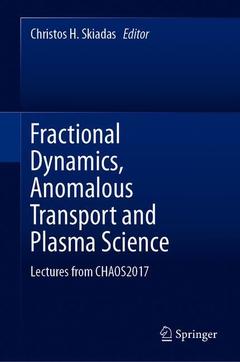Fractional Dynamics, Anomalous Transport and Plasma Science, 1st ed. 2018 Lectures from CHAOS2017
Coordonnateur : Skiadas Christos H.

This book collects interrelated lectures on fractal dynamics, anomalous transport and various historical and modern aspects of plasma sciences and technology.
The origins of plasma science in connection to electricity and electric charges and devices leading to arc plasma are explored in the first contribution by Jean-Marc Ginoux and Thomas Cuff. The second important historic connection with plasmas was magnetism and the magnetron. Victor J. Law and Denis P. Dowling, in the second contribution, review the history of the magnetron based on the development of thermionic diode valves and related devices. In the third chapter, Christos H Skiadas and Charilaos Skiadas present and apply diffusion theory and solution strategies to a number of stochastic processes of interest. Anomalous diffusion by the fractional Fokker-Planck equation and Lévy stable processes are studied by Johan Anderson and Sara Moradi in the fourth contribution. They considerthe motion of charged particles in a 3-dimensional magnetic field in the presence of linear friction and of a stochastic electric field. Analysis of low-frequency instabilities in a low-temperature magnetized plasma is presented by Dan-Gheorghe Dimitriu, Maricel Agop in the fifth chapter. The authors refer to experimental results of the Innsbruck Q-machine and provide an analytical formulation of the related theory. In chapter six, Stefan Irimiciuc, Dan-Gheorghe Dimitriu, Maricel Agop propose a theoretical model to explain the dynamics of charged particles in a plasma discharge with a strong flux of electrons from one plasma structure to another. The theory and applications of fractional derivatives in many-particle disordered large systems are explored by Z.Z. Alisultanov, A.M. Agalarov, A.A. Potapov, G.B. Ragimkhanov. In chapter eight, Maricel Agop, Alina Gavrilut? and Gabriel Crumpei explore the motion of physical systems that take place on continuous but non-differentiable curves (fractal curves). Finally in the last chapter S.L. Cherkas and V.L. Kalashnikov consider the perturbations of a plasma consisting of photons, baryons, and electrons in a linearly expanding (Milne-like) universe taking into account the metric tensor and vacuum perturbations.
Christos Skiadas was the Founder and Director of the Data Analysis and Forecasting Laboratory in the Technical University of Crete. His main scientific and research interests are innovation and innovation diffusion modelling and forecasting, life table data modelling and healthy life expectancy estimates, including applications in finance and insurance.
He is currently President of ISAST (International Society for the Advancement of Science and Technology, a non-profit organization) and Chairman of ASMDA International and partner of ManLab Technical University of Crete, Chania, Crete, Greece while he chairs the annual Demographics Workshop and Conference and an annual CHAOS Conference including the Plasma Section.
Date de parution : 12-2018
Ouvrage de 201 p.
15.5x23.5 cm



